Holy Heroes: Saints in the United States
The 11 canonized saints of the United States, and the five Blesseds as well as the numerous Venerables who are on the path to official recognition as saints, are a true representation of the best of the Land of the Free. Many were immigrants and others were born here. Some came as missionaries. They include a Native American saint, and African Americans and members of despised immigrant groups whose personal sanctity overcame bigotry in the name of Jesus. They all shared a commitment to evangelizing the Gospel and helped build our country with schools, hospitals, orphanages and much more.
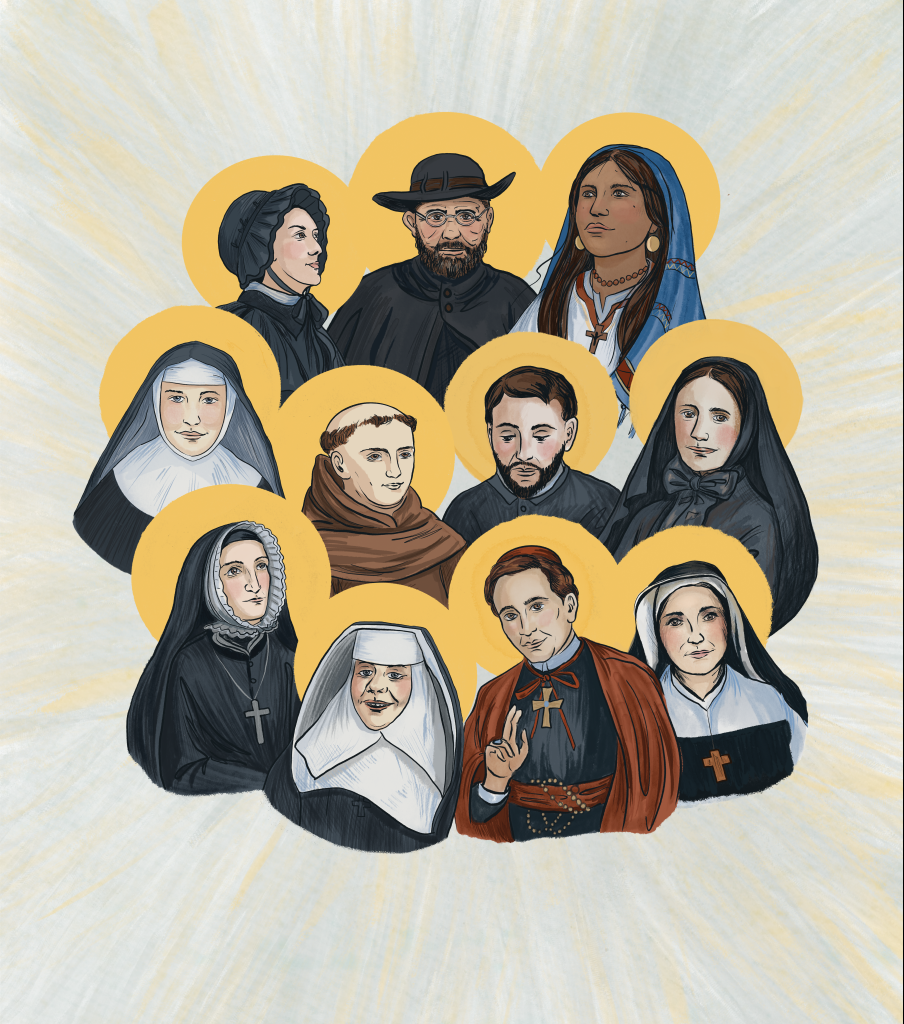
St. Damien of Molokai (1840–1889)
Missionary to the lepers of Molokai, Hawaii
Patron saint of lepers and outcasts

St. Damien de Veuster of Molokai is world renowned for his life of sacrificial Christianity as the missionary to the lepers of Molokai, eventually contracting and dying of leprosy in 1889. In modern times, he has been claimed as the patron saint of AIDS sufferers and outcasts as well.
Today leprosy or Hansen’s disease is curable, but at that time leprosy was a life sentence to isolation, disfigurement and death.
Born in Belgium in 1840 to a poor farmer and his wife, St. Damien entered the Congregation of the Sacred Hearts of Jesus and Mary at 19. Damien’s older brother, a priest in this congregation, was slated for mission in Hawaii but he fell ill, and Damien offered to go in his place. He was ordained a priest in Honolulu two months after his arrival in 1864.
The lepers of Molokai had asked for a priest, but when Father Damien arrived the colony was poorly maintained, without order, with despair, drinking and severe immorality, and no one to care for the dying. St. Damien persuaded the lepers to work together and they built houses, schools and the parish church of St. Philomena. He was later joined in his work by St. Marianne Cope and her Franciscan sisters.
Under the leadership of these two saints, Molokai became a truly Christian society. St. Damien was the only priest in the colony. Sometimes, a priest would come on a supplies boat, and Damien would have to confess by shouting his sins in Latin from the shoreline.
In 1885, St. Damien contracted leprosy. From then until his death, in his homilies he would say, “We, lepers.”
In 1936, when Father Damien was being considered for sainthood, King Leopold of Belgium asked President Franklin Delano Roosevelt to return Damien’s body to Belgium from the Territory of Hawaii. The ship stopped in San Francisco where his body was carried in a cortege through the city and, for five days his body lay in state, under 24-hour military guard, at St. Mary’s Cathedral, revered by tens of thousands with Mass offered by Archbishop John J. Mitty.
In 1995, Pope St. John Paul returned St. Damien’s right hand to the people of Hawaii where it is buried at his original burial spot on Molokai. He was canonized on Oct. 11, 2009, by Pope Benedict XVI. 1
Feast day: May 10.
St. Elizabeth Ann Seton (1774–1821)
Founder of the Sisters of Charity of St. Joseph. Considered founder of the Catholic school system in the U.S.
Patron saint of Catholic schools, widows and seafarers

St. Elizabeth Ann Seton is the first American-born saint canonized by the Catholic Church and she is also credited as one of the pioneers of Catholic education. Born into a prominent Episcopalian family in New York City, at 19 St. Elizabeth married wealthy William Magee Seton and they had a happy marriage with five children. When after 10 years her husband died of tuberculosis in Italy where they had gone hoping for a cure, she returned to New York City where she became Catholic. In Italy, she had fallen in love with the Eucharist. Rejected by her family for her Catholicism and impoverished, she moved to Baltimore and eventually in 1809 to Emmitsburg, Maryland, where she founded the Sisters of Charity of St. Joseph’s, the first community for religious women established in the United States. She also began St. Joseph’s Academy and Free School. Her legacy includes religious congregations in the United States and Canada, whose members work on the unmet needs of people living in poverty in North America and beyond. Mother Seton, as she is often called, was canonized Sept. 14, 1975, in St. Peter’s Square by Pope St. Paul VI. Her remains are in the Basilica at the National Shrine of Saint Elizabeth Ann Seton in Emmitsburg. 2
Feast day: January 4.
St. Frances Xavier Cabrini (1850–1917)
Missionary and founder of the Missionary Sisters of the Sacred Heart of Jesus
Universal patroness of immigrants

St. Frances Xavier Cabrini, who was born two months prematurely, the youngest of a family of 13 in northern Italy, is universally revered as a patron saint of immigrants. Due to poor health, her first request to join a religious community was refused, but she was finally able to take her vows in 1877 and was named prioress of the Missionary Sisters of the Sacred Heart. Pope Leo XIII urged her to go as a missionary to the United States, rather than to China where she first felt called and sent Mother Cabrini and six of her sisters to the U.S.
In New York City, the house that had been promised to her for an orphanage was unavailable, and the archbishop advised her to return to Italy. St. Frances stayed and established the orphanage. Not just a saint but a shrewd businesswoman, she and her sisters made a huge difference for Italian immigrants, notes AmericanCatholicHistory.org: “She personally founded 67 schools, hospitals and orphanages in New York, Chicago, Denver, New Orleans, Seattle and other cities in the U.S. and other countries.”
Mother Cabrini was deathly fearful of water, yet she traveled across the Atlantic Ocean 30 times. She is quoted as having stated, “I will go anywhere and do anything in order to communicate the love of Jesus to those who do not know him or have forgotten him.” She became an American citizen in 1909. She died of malaria in Chicago in 1917. On July 7, 1946, Pope Pius XII proclaimed Mother Cabrini a saint, making her the first American citizen saint. In 1950, the Catholic Church named her universal patroness of immigrants for her work for immigrants around the world. 3
Feast day: November 13.
St. Isaac Jogues and the North American Martyrs (1607-1646)
Jesuit priest, missionary and one of the North American martyrs
Patron saint of the Americas and Canada
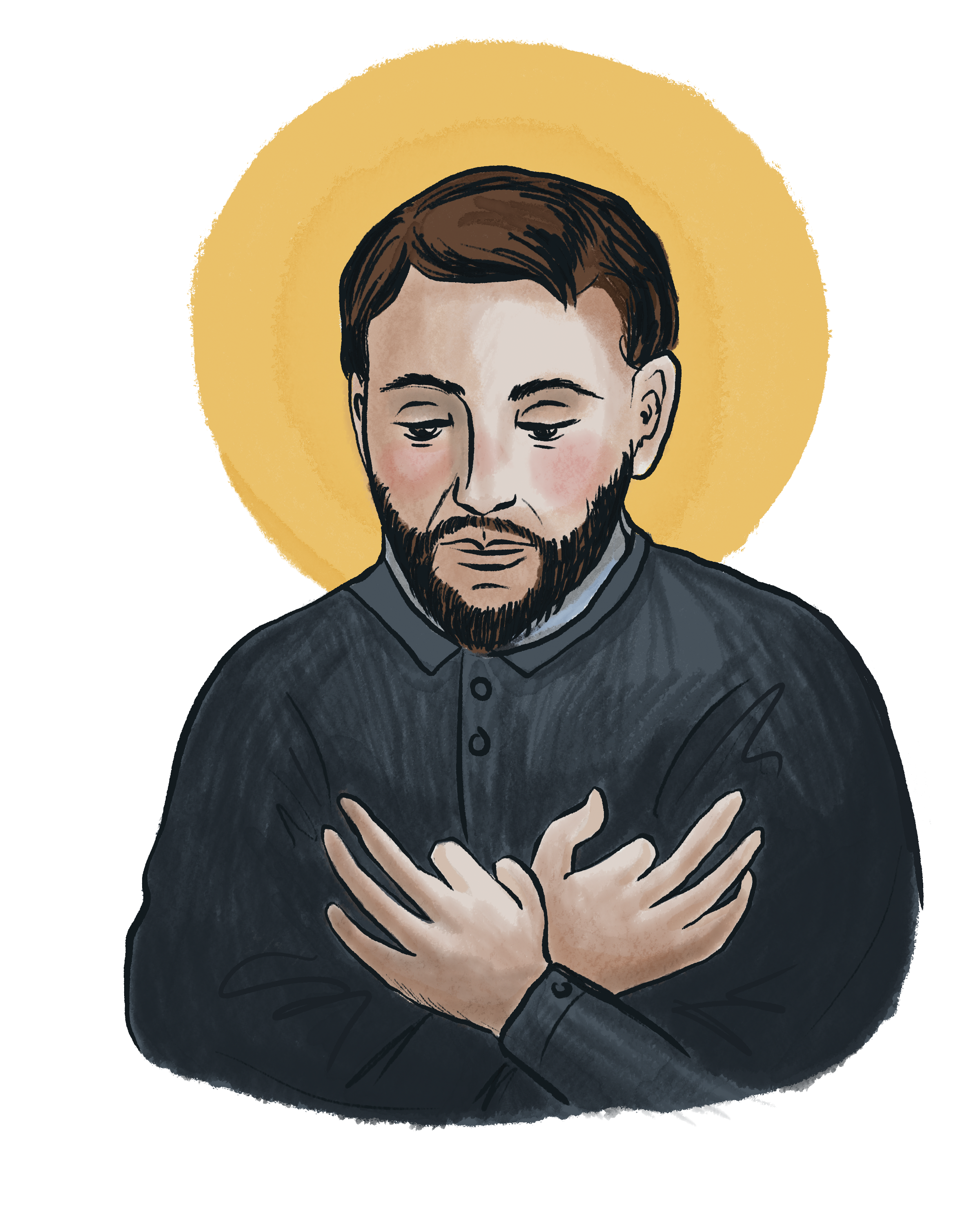
During the year following his ordination in 1636, St. Isaac Jogues had his dearest wish fulfilled: to be a missionary to the Native Americans in New France. In 1641, he and a group of fellow missionaries traveled to Iroquois country. There, the missionaries were whipped, bitten and tormented. St. Isaac Jogues watched his friends die around him and was constantly threatened by death himself. After a year, in which St. Isaac was able to evangelize and baptize a few of the Iroquois, he escaped, boarding a Dutch ship and returning to France. He returned in months, and because his fingers and thumbs had been bitten or cut off, he had to obtain special permission from Pope Urban VIII, who considered him to be a “living martyr,” to celebrate Holy Mass without the proper digits. St. Isaac predicted this would be his last trip and wrote to a fellow Jesuit, saying, “My heart tells me that if I am the one to be sent on this mission, I shall go but I shall not return. But I would be happy if our Lord wished to complete the sacrifice where he began it.” He was killed with a tomahawk in 1646. St. Isaac and his companions were canonized by Pope Pius XI in 1930 as the North American Martyrs. They include the two who died with him and four others who were killed during that general time. St. Kateri Tekakwitha was born about 10 years after St. Isaac died, in the same village where he gave his life for his faith, according to faith.nd.edu. He is the patron saint of the Americas and Canada. 4
Feast day: October 19.
St. John Neumann (1811-1860)
Missionary and fourth bishop of Philadelphia. Founded the first diocesan Catholic school system in U.S.
Patron of sick children and immigrants
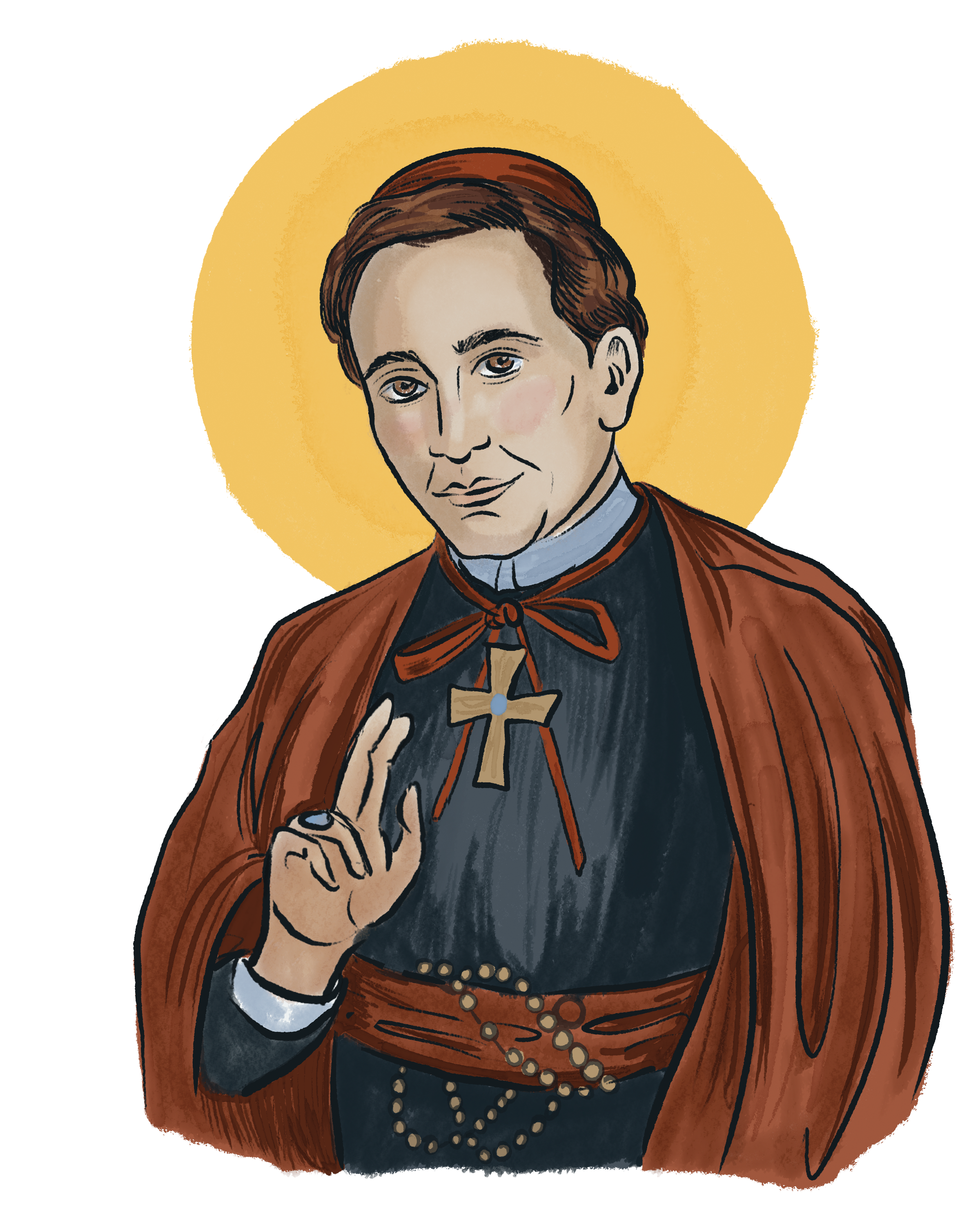
St. John Neumann, the fourth bishop of Philadelphia, a tireless missionary and priest who founded the first diocesan Catholic school system in the U.S., almost did not become a priest. Born in Bohemia, what is now the Czech Republic, he studied for the priesthood but because of a surplus of priests was not ordained. He traveled to New York where he was ordained in 1836 and in 1842 entered the Redemptorists. At 41, he was named bishop of Philadelphia. In just seven years, he built 89 churches, as well as several hospitals and orphanages. Under his guidance, a parochial school system was established.
Pope Venerable Pius XII said of St. John Neumann at the 150th anniversary of the Philadelphia Archdiocese: “It was mainly through his prodigious efforts that a Catholic school system came into being and that parochial schools began to rise across the land.” As a bishop, St. John Neumann was untiring in visiting his vast diocese. On Jan. 5, 1860, at the age of 48, he died suddenly of a heart attack on a Philadelphia street.
St. John Neumann was beatified during the Second Vatican Council on Oct. 13, 1963, and was canonized on June 19, 1977. In the homily on the occasion of Neumann’s canonization, Pope St. Paul VI said: “He was close to the sick, he loved to be with the poor, he was a friend of sinners, and now he is the glory of all emigrants.” 5
Feast day: January 5.
St. Junípero Serra (1713-1784)
Founder of the Spanish missions in California
Patron saint of California, Hispanic Americans and vocations

At St. Junípero Serra’s canonization in 2015, the only canonization on U.S. soil, Pope Francis said we are all called to imitate St. Junípero Serra. “He was the embodiment of ‘a Church which goes forth,’ a Church which sets out to bring everywhere the reconciling tenderness of God,” Pope Francis said at the Basilica of the National Shrine of the Immaculate Conception in Washington.
As a young man in Spain, St. Junípero Serra joined the Franciscan order and began a short career as a professor, famous for his preaching. When he was 35, he began to yearn for the life of a missionary in the New World. He left everything behind and boarded a ship bound for Vera Cruz, Mexico. On his way to Mexico City, an insect bite infected his leg so badly that walking pained him for the rest of his life but it did not stop him. He founded nine of the 21 California missions. Even through painfully hobbled, he traveled up and down the coast of modern-day California, motivated by his concern for the native population and his zeal for sharing the Christian faith. He is buried at the Carmel Mission. He is venerated by Catholics and non-Catholics alike as the apostle and father of California. 6
Feast day: July 1.
St. Kateri Tekakwitha (1656-1680)
Native American and consecrated virgin
Patron saint of Native Americans and the environment
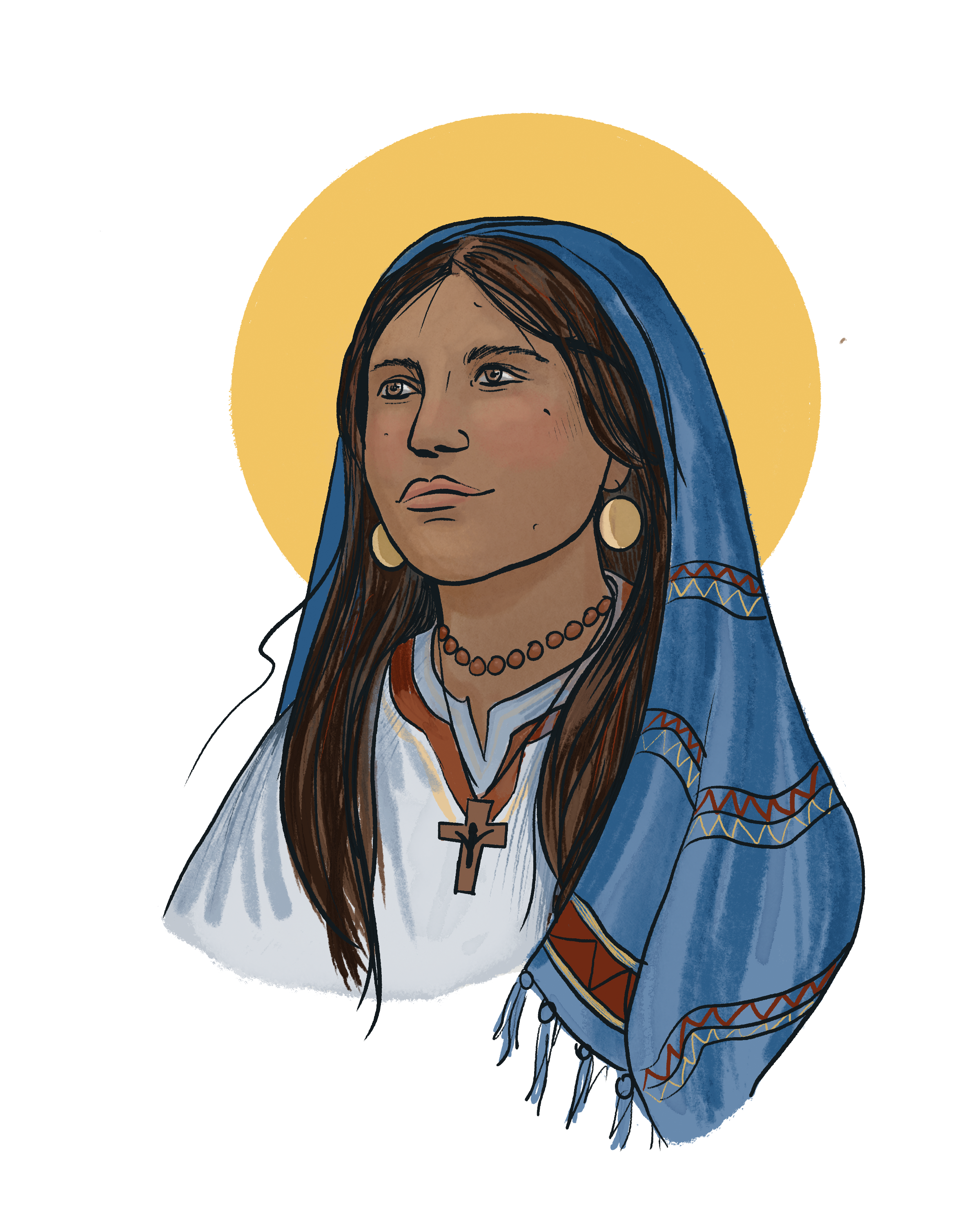
St. Kateri Tekakwitha is the first Native American canonized by the Catholic Church. She died at the age of 24 at least partially from lingering effects of the smallpox she survived as a child, a disease that killed her parents and left her an orphan at 4. Smallpox scarred her face and damaged her eyesight. Because of this handicap she was called “She who bumps into things,” or in Mohawk, “Tekakwitha,” AmericanCatholicHistory.org reports. She was raised by her uncle, the chief of the Mohawk village. When priests came to the village, St. Kateri converted at the age of 19 and was baptized with the Mohawk form of the name “Catherine,” which is “Kateri.” Because she refused to work on Sundays, she was denied meals that day. Finally, a missionary encouraged her to run away to Montreal, Canada, where she lived in Kahnawake, a village for Native Americans who had become Catholic. Surrounded by fellow Catholics, she was aflame with divine love and lived a life of intense prayer and penance, taking a vow of virginity and becoming a bride of Jesus Christ. She was beatified in 1980 and canonized on Oct. 21, 2012, by Pope Benedict XVI. 7
Feast day: July 14.
St. Marianne Cope (1838 – 1914)
Missionary to the lepers of Molokai, Hawaii
Patron saint of lepers, outcasts, those with HIV/AIDS and Hawaii
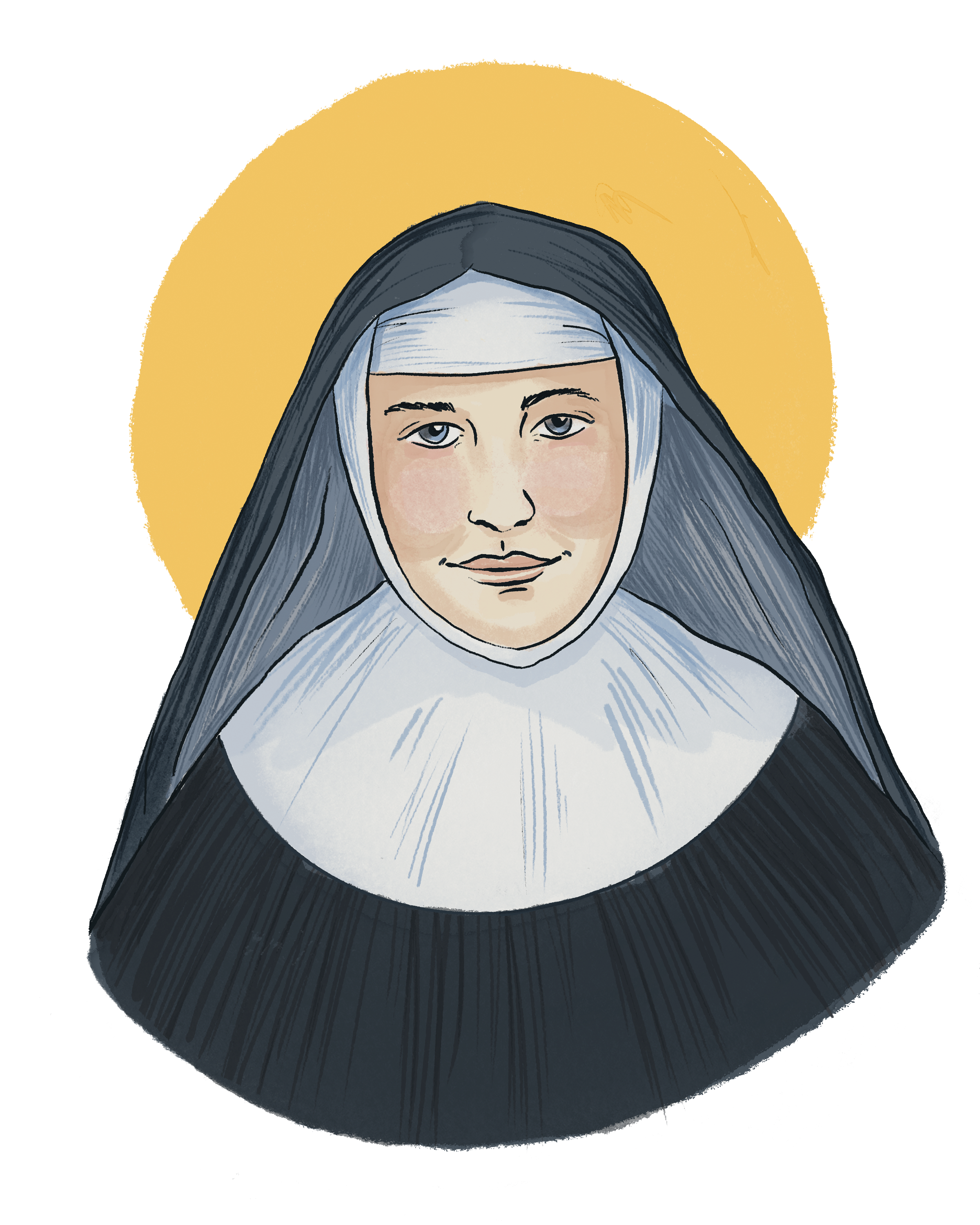
St. Marianne Cope is also known as St. Marianne of Molokai for her work with lepers. She was born in Germany but when she was a year old her family moved to Utica, New York. As one of the older children of a large family, she went to work in a factory after the eighth grade, later joining the Sisters of the Third Order of St. Francis. A gifted administrator, she was principal of a parish school and directed two hospitals. By 1883, Sister Marianne had become the superior general of her congregation, when she received a plea for help from Hawaii. King Kalakaua himself sent the letter asking for co-workers to help St. Damien at the Molokai leper colony. Mother Marianne responded generously, leaving Syracuse with six sisters and arriving in Hawaii on Nov. 8, 1883. For the next 35 years she worked for the lepers, tirelessly devoted to their welfare even when she was confined to a wheelchair. She was canonized by Pope Benedict XVI in 2012. 9
Feast day: January 23.
St. Katharine Drexel (1858–1955)
Founder of Xavier University, the first Catholic university for African Americans, and founder of the Sisters of the Blessed Sacrament for Indians and Colored People
Patron saint of racial justice and philanthropists
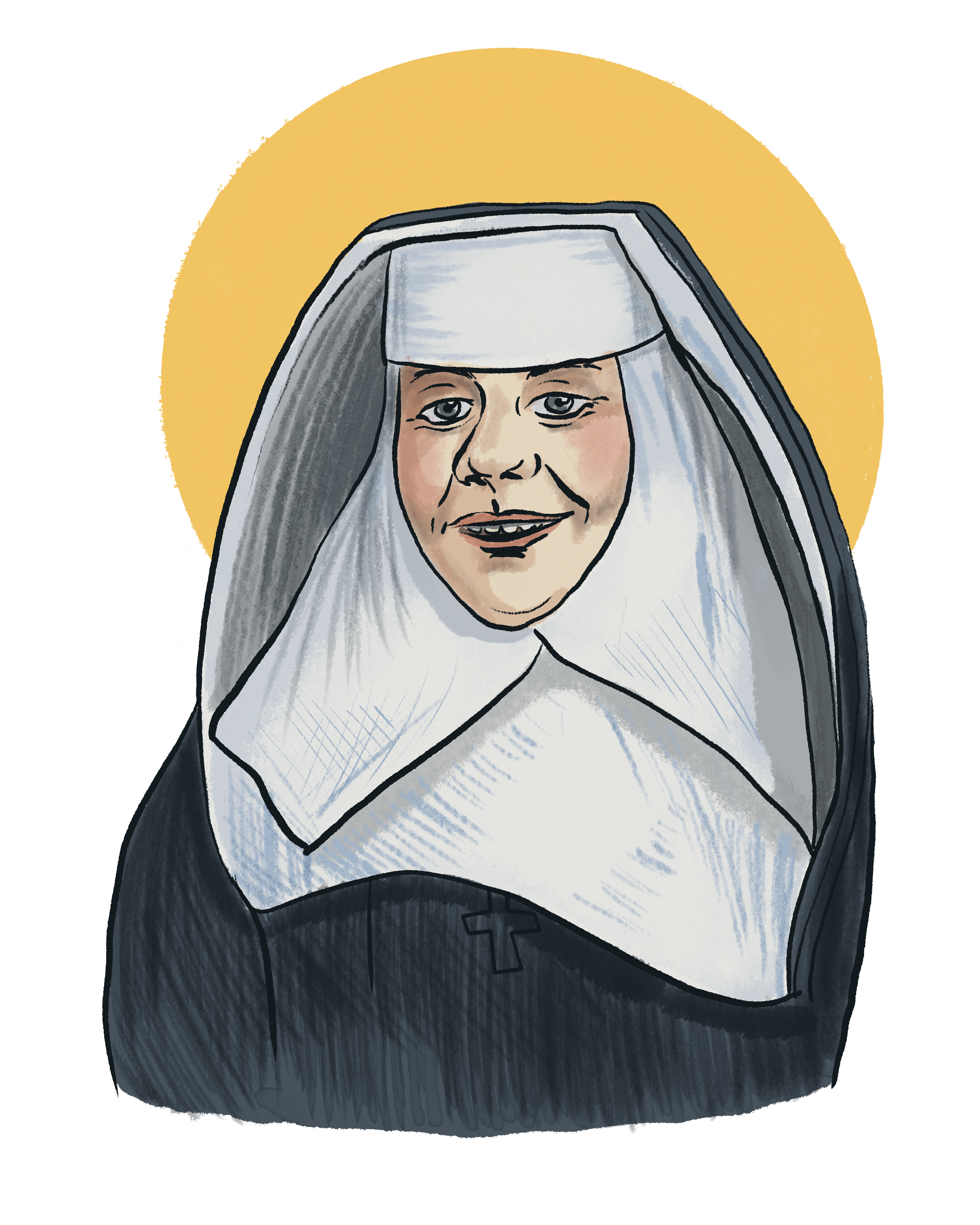
St. Katharine Drexel was an heiress from one of the wealthiest families in the U.S. who went on to found the first Catholic university for African Americans.
Her mother died when she was five weeks old, but she was raised by a beloved stepmother and father who had a deep sympathy for the poor. In her travels she saw the horrid conditions on Indian reservations and as a layperson and then a religious she gave up everything to become a missionary to Native Americans and African Americans. The story is recounted on the USSCB website that when she asked Pope Leo XIII to send more missionaries to Wyoming, he asked her, “Why don’t you become a missionary?”
She was crafty and politically savvy, working around Jim Crow laws in the South that prohibited Blacks and whites sitting together in church, as one example, notes writer Anthony Walton. She set up church seating so that the separation ran from front to back so that both whites and Blacks were sitting parallel to each other rather than with Blacks in the back, notes Walton in “The Eye of the Needle: Katharine Drexel,” published by Notre Dame Magazine in August of 2004. “Xavier University in New Orleans stands as perhaps the most notable testament to the force of Katharine Drexel’s vision. Xavier was founded in 1915 through an initial grant of $750,000 from Drexel. The only historically Black Catholic college in the United States, Xavier was — according to nuns of her order — one of the projects closest to Drexel’s heart.”
St. Katharine founded schools in 13 states for African Americans, 40 mission centers and 23 rural schools. She also established 50 missions for Indians in 16 different states. She died at the age of 96 and was canonized by Pope St. John Paul in 2000. 8
Feast day: March 3.
St. Rose Philippine Duchesne (1769–1852)
Missionary to Native Americans
Patron saint of perseverance among adversity

St. Rose Philippine Duchesne’s lifelong desire from her time as a girl in a wealthy family in France was to be a missionary to the Native Americans. However, over and over throughout her life she found her dearest goal stymied.
She entered the Visitation of Mary convent at 19 and remained despite family opposition, until the convents were shut down by the French Revolution. Ten years later she was able to join the newly formed Society of the Sacred Heart and in 1818, at age 49, she and four nuns traveled from France to St. Louis, Missouri, only to find the bishop had no place for them to live and work with Native Americans. Instead, he sent her to what she called “the remotest village in the U.S.,” St. Charles, Missouri.
There she founded the first free school for girls in U.S. territory west of the Mississippi as well as the first Catholic school in U.S. territory for Native Americans.
Finally at age 72, retired and in poor health, St. Rose realized her lifelong wish. A mission was founded at Sugar Creek, Kansas, among the Potawatomi and she was taken along. Though she could not learn their language, they soon named her “Woman-Who-Prays-Always.” While others taught, she prayed, witnessing to the primacy of the contemplative life and intercessory prayer in the missionary activity of the Church. Legend says that children sprinkled bits of paper on Sister Rose’s habit as she knelt and came back hours later to find them undisturbed. St. Rose Duchesne died in 1852, at the age of 83. 10
Feast day: November 18.
St. Mother Théodore Guérin (1784-1856)
Missionary and founder of the Sisters of Providence of Saint Mary-of-the-Woods
Patron saint of Diocese of Vincennes, Indiana

St. Théodore Guérin was born Oct. 2, 1784, in Etables, France. When she received her first Holy Communion at the age of 10, she announced to the parish priest that she would one day be a nun. At 25, she entered the Sisters of Providence of Ruillé-sur-Loir, whose mission was to educate children and to care for the poor, sick and dying. In 1840, at the age of 56, Sister Théodore was asked to lead a small band of missionary sisters to Indiana in the United States. When the sisters arrived, there was only a log cabin with a porch that served as a chapel. Though her health was suffering, Mother Théodore embraced this new task with a strong and generous will. By the time she died in 1856, St. Théodore had opened schools in Illinois and throughout Indiana. The sisters were well-established and respected. Through illness, poverty and all manner of unwelcoming circumstances, she trusted in God’s providence and lived as a model of belief in his mercy, especially when human calculations judge a task impossible. She was canonized in 2006 and is the patron saint of Indianapolis. 11
Feast day: October 3.
U.S. Blesseds:
Blessed Father Francis Xavier Seelos (1819-1867). Missionary preacher. Died ministering to victims of yellow fever in New Orleans, October 5.
Blessed Michael McGivney (1852-1890). Founder of the Knights of Columbus, August 13.
Blessed Sister Miriam Teresa (Teresa Demjanovich) (1901-1927). Religious sister devoted to prayer and teaching, May 8.
Blessed Father Stanley Rother (1935-1981). Missionary and martyr in Guatemala, July 28.
Blessed Father Solanus Casey (1870-1957). Capuchin priest, miracle worker, lover of the sick, July 30.
American Venerables:
Venerable Pierre Toussaint (1776-1853). Haitian-American husband and father, hairdresser, former slave, generous benefactor, attended Holy Mass daily for 66 years.
Venerable Henriette Delille (1813-1862). Louisiana Creole of color, founder of religious community dedicated to evangelization of African Americans, Congregation of the Sisters of the Holy Family.
Venerable Father Augustus Tolton (1854-1897). First publicly known African American priest.
Venerable Father Nelson Baker (1842-1936). Parish priest and founder of Our Lady of Victory “city of charity” near Buffalo, New York.
Venerable Bishop Frederic Baraga (1797-1868). Missionary bishop and grammarian of Native American languages.
Venerable Mother Mary Magdalen Bentivoglio (1834-1905). Contemplative nun who loved prayer and poverty. Incorrupt remains at exhumation.
Venerable Cornelia Connelly (1809-1879). Adult convert to Catholicism, suffered intensely from family problems, devoted wife, mother, and nun.
Venerable Mother Mary Theresa Dudzik (1860-1918). Religious sister in Chicago, devoted to care for the poor and elderly.
Venerable Bishop Alphonse Gallegos (1931-1991). Auxiliary Bishop of Sacramento. Nicknamed “Bishop of the Barrios.” Ministered to at-risk youth at night in poor areas.
Venerable Mother Maria Kaupas (1880-1940). Religious sister devoted to teaching and evangelization.
Venerable Mother Mary Angeline Teresa McCrory (1893-1984). Carmelite sister in service of impoverished elderly.
Venerable Archbishop Fulton Sheen (1895-1979). Bishop, missionary, preacher, philosopher, teacher, radio and television star, 1953 Emmy Award winner.
Venerable Father Felix Varela (1788-1853). Cuban-American priest and refugee. Philosopher, intellectual father of Cuba. Worked on development of the Baltimore Catechism.
llustrated by Shaylynn Rackers
Information compiled by Valerie Schmalz and Joseph Previtali
1. Information courtesy of USCCB, Catholic.org, America Magazine, Catholic News Service archives, and catholichawaii.org/catholic-essentials/saints-traveling-relics/history-of-hawaiis-saints/saint-damien
2. Information courtesy the USCCB and SetonShrine.org
3. Information courtesy USCCB, AmericanCatholicHistory.org, https://giveninstitute.com/st-frances-xavier-cabrini/ and cabrininationalshrine.org
4. Information courtesy the USCCB and faith.nd.edu
5. Information courtesy of USCCB and National Shrine of St. John Neumann, stjohnneumann.org
6. Information courtesy USCCB. More information available at cacatholic.org/saint-junipero-serra-california-missions
7. Information courtesy of USCCB, Catholic.org and AmericanCatholicHistory.org
8. Information courtesy USCCB, Notre Dame Magazine, and katharinedrexel.org
9. Information courtesy USCCB, Catholic.org and catholichawaii.org/catholic-essentials/saints-traveling-relics/history-of-hawaiis-saints/saint-marianne/
10. Information courtesy of USCCB, AmericanCatholicHistory.org, and Franciscan Media
11. Information courtesy USCCB

